This Instant Pot Takikomi Gohan is a traditional Japanese mixed rice with chicken and vegetables that is pressure cooked in a savory dashi broth. This time-saving recipe makes for a delicious and quick weeknight meal!
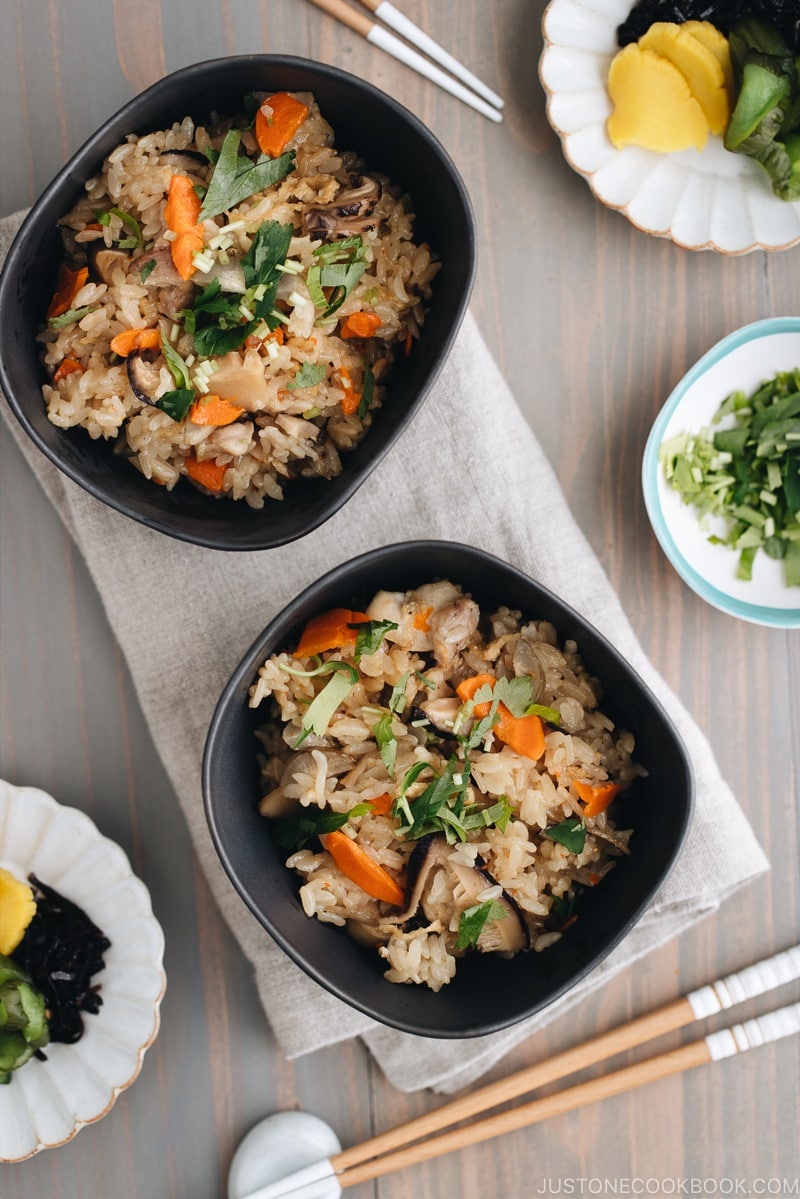
Looking for more ways to cook various rice dishes in your instant pot? Today, we will use the trusty pressure cooker to make Instant Pot Takikomi Gohan, a versatile Japanese rice dish with a colorful mix of ingredients. This one-pot dish is wholesome and comforting to enjoy on a hectic weeknight.
This rice recipe is specifically created for those of you who love to cook with the Instant Pot. If you don’t own one, I encourage you to prepare my classic Takikomi Gohan recipe in the rice cooker!
Table of Contents
What is Takikomi Gohan?
Takikomi gohan (炊き込みご飯) is a Japanese rice dish seasoned with dashi and soy sauce and cooked with mushrooms, vegetables, and meat or fish.
Takikomi gohan often includes seasonal ingredients such as matsutake (wild pine) mushrooms in Matsutake Gohan or chestnuts in Kuri Gohan. We also use different ingredients to make all kinds of variations, like Gobo and Miso Takikomi Gohan, Sweet Onion Takikomi Gohan, Ginger Rice, and Sansai Gohan (Rice with Mountain Vegetables).
There is a similar dish called mazegohan (混ぜ御飯) or maze gohan in which flavorful ingredients are mixed into the rice after it’s cooked. Ume Shiso Rice is one of my popular mazegohan recipes.
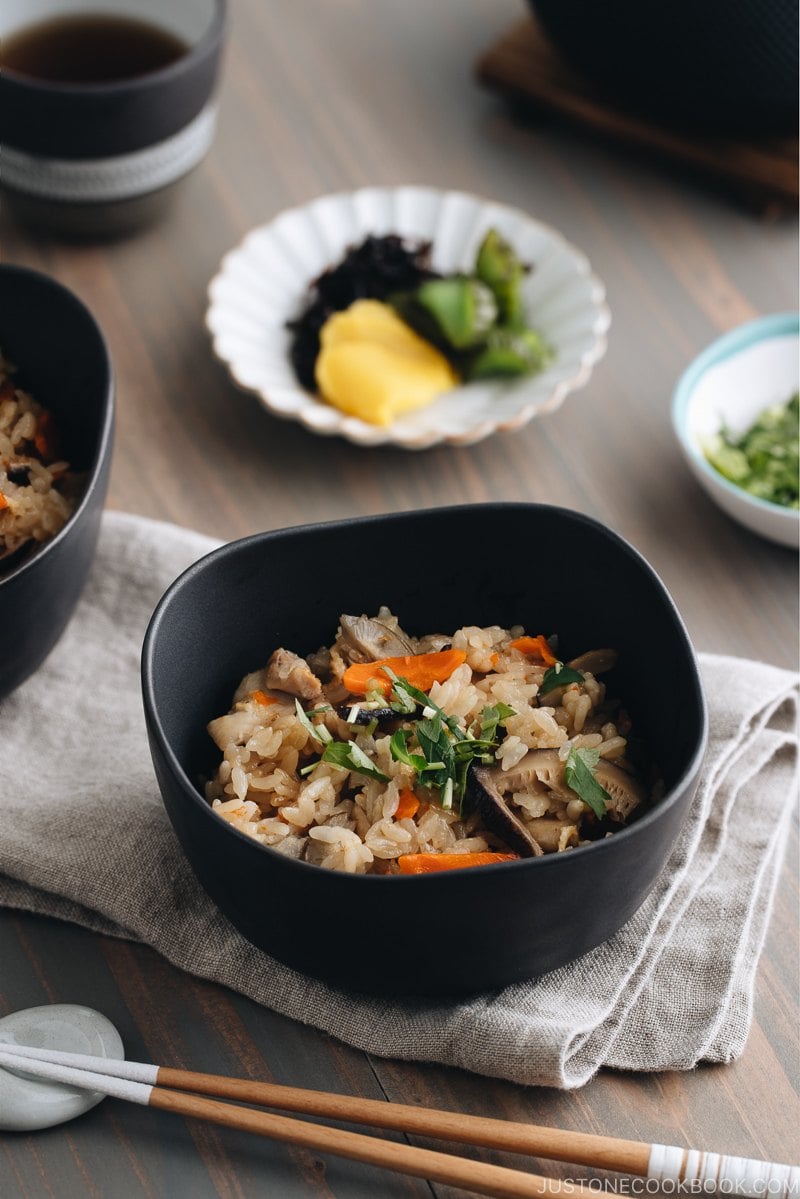
Ingredients for Takikomi Gohan
- Japanese short-grain white rice
- dried shiitake mushrooms
- water (to rehydrate the shiitake)
- chicken thigh
- sake – for marinating the chicken
- gobo (burdock root)
- carrot
- aburaage (deep-fried tofu pouch)
- mitsuba (Japanese parsley) – for garnish; or use green onion
- dashi (Japanese soup stock) – use standard Awase Dashi, dashi packet or powder, or Vegan Dashi
- soy sauce – use gluten-free soy sauce for GF
- mirin
- Diamond Crystal kosher salt
Substitutions and Variations
Besides being convenient, takikomi gohan makes a great template for trying new flavor combinations. You can definitely make yours with whatever you like!
- Try fresh mushrooms. Use fresh shiitake mushrooms or other mushrooms if you can’t find dried shiitake. While dried shiitake produces a delicious shiitake dashi (stock) through the soaking water that we use to cook the rice, the fresh kind still has an amazing aroma and flavor.
- Use other root vegetables. If you can’t find burdock root, you can skip it and add other root vegetables, such as turnips.
- Substitute deep-fried tofu cubes. I love including aburaage because it adds extra flavor and texture to the mixed rice. If you can’t find it in the freezer or tofu section at Japanese grocery stores, use a similar deep-fried tofu that is a small cube shape carried at some Asian grocery stores.
- Use chives or green onion/scallion. Mitsuba is a Japanese herb that makes the dish extra tasty, yet it is extremely hard to find if you don’t have a well-stocked Japanese grocery store. Use chives or green onion/scallion instead to add some green color.
- Swap your favorite Japanese soup stock (dashi). Use any Japanese dashi you like, including Awase Dashi (kombu + katsuobushi), Kombu Dashi, and Shiitake Dashi. Do not substitute chicken or beef stock.
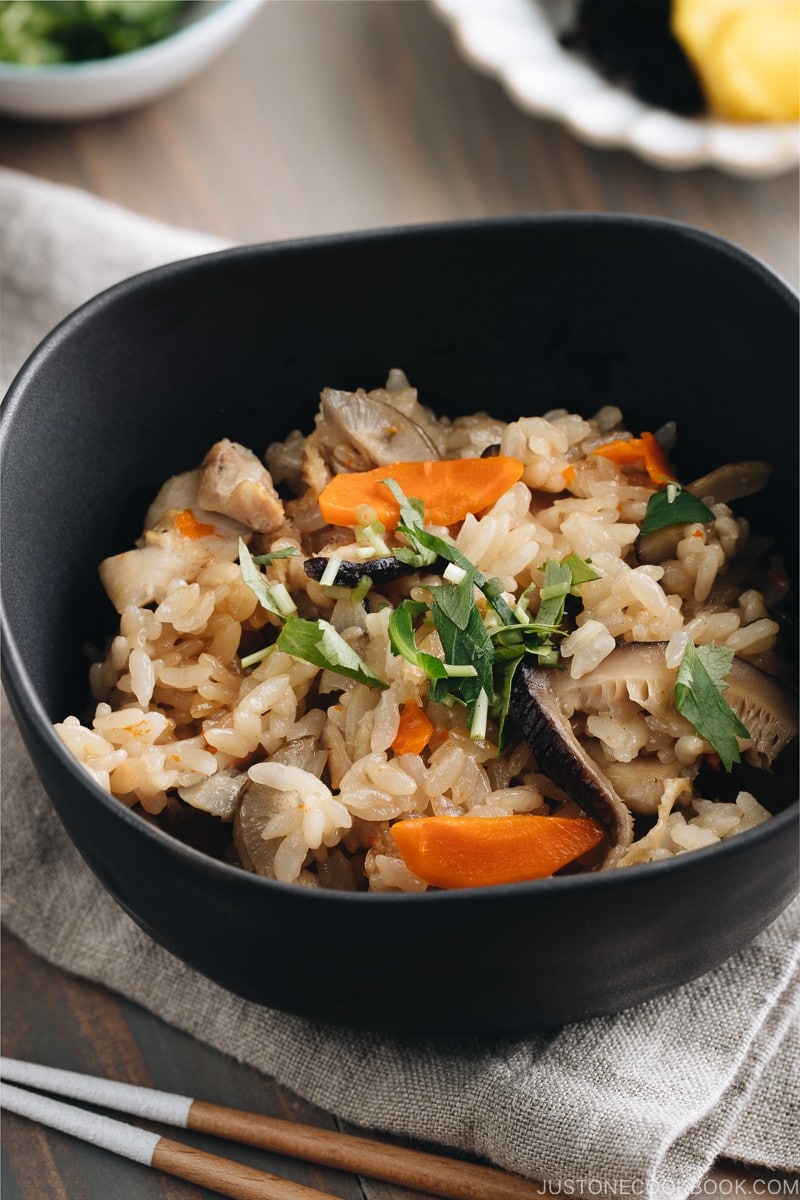
How To Cook Instant Pot Takikomi Gohan
- Make the dashi and let it cool.
- Wash and soak the rice in water for 20–30 minutes, then drain well.
- Meanwhile, rehydrate the dried shiitake mushrooms in a small bowl of water until tender.
- Cut the chicken into bite-sized pieces and sprinkle with sake.
- Scrape off the gobo skin and thinly slice it diagonally, then soak in water. Thinly slice the carrot diagonally. Rinse off the aburaage with hot water, then cut into thin slices and squeeze out the water.
- Squeeze out the shiitake liquid into the bowl and reserve the soaking liquid as shiitake dashi. Cut off the stems and thinly slice the mushroom caps.
- Make the seasoning liquid. Add the shiitake dashi, soy sauce, mirin, and salt to a measuring cup. Add enough awase dashi to make the required amount of liquid. Combine this seasoning liquid with the chicken and veggie ingredients. Mix well.
- Transfer the well-drained rice to the inner pot and level it. Then, evenly distribute the ingredients and seasoning liquid on top of the rice. DO NOT MIX.
- Close the lid. Click Manual, set to high pressure for 2 minutes, and press Start.
- When it’s finished cooking, let the pressure release naturally for 10 minutes. Then, quick release and open the lid. Fluff the rice with a rice scooper, using a slicing motion. Serve in individual bowls and garnish with chopped mitsuba.
4 Cooking Tips for Instant Pot Takikomi Gohan
1. Cut the ingredients a similar size.
There are two reasons for this. First, you don’t want to eat big and chunky ingredients with soft, tender rice. Also, all the ingredients cook at the same time; therefore, you need to cut the tougher ingredients slightly smaller even than the more tender ingredients.
2. Add the seasonings just before cooking.
To give the plump and thick Japanese short-grain rice a head start, make sure to soak it in water for 20–30 minutes and drain well. Wait to add the soy sauce and salt (along with the cooking liquid) until just prior to cooking. The soy sauce and salt actually prevent the rice from absorbing water, so we can’t add them during the soaking step.
3. Do not mix the ingredients into the uncooked rice.
When you add the chicken and veggies to the uncooked rice, resist the urge to mix it! For the rice to cook evenly, it must stay below the ingredients and submerged in the cooking liquid.
4. Release the pressure naturally after exactly 10 minutes.
When it’s done cooking, set a 10-minute timer for natural release of pressure. After exactly 10 minutes, quick release the remaining pressure by opening the valve. Then, immediately open the lid to fluff the rice and release the extra moisture.
I hope you can lean on this popular recipe in Japanese cooking anytime you need a satisfying meal for the family!
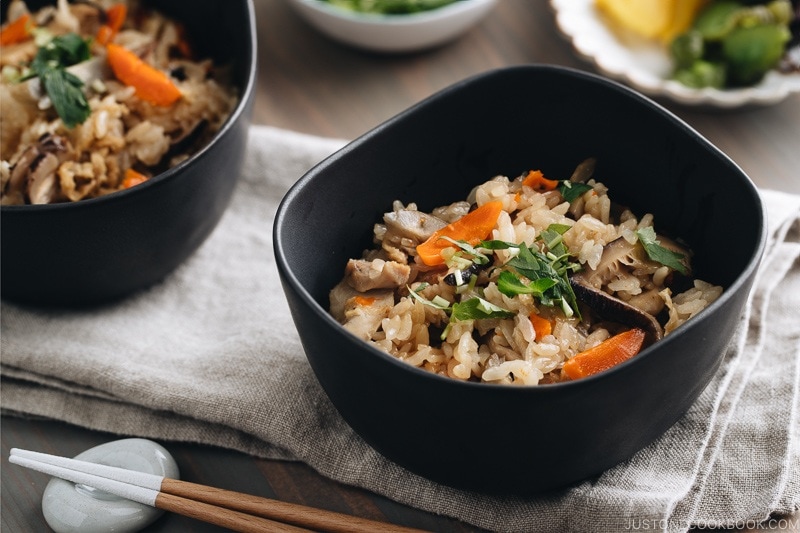
Wish to learn more about Japanese cooking? Sign up for our free newsletter to receive cooking tips & recipe updates! And stay in touch with me on Facebook, Pinterest, YouTube, and Instagram.

Instant Pot Takikomi Gohan
Video
Ingredients
- 1½ cups uncooked Japanese short-grain white rice (2 rice cooker cups, 360 ml)
- 2 dried shiitake mushrooms
- ¼ cup water (to rehydrate the shiitake)
- 1 chicken thigh (4–5 oz, 113–142 g)
- ½ Tbsp sake (for marinating the chicken)
- 1.8 oz gobo (burdock root) (about ⅓ cup sliced)
- 1.8 oz carrot (about ⅓ cup sliced)
- 1 piece aburaage (deep-fried tofu pouch) (about ⅓ cup sliced)
- 3 sprigs mitsuba (Japanese parsley) (for garnish; or use green onion)
For the Seasonings
- 1½ cups dashi (Japanese soup stock) (use standard Awase Dashi, dashi packet or powder, or Vegan Dashi)
- 1½ Tbsp soy sauce (use gluten-free soy sauce for GF)
- 1 Tbsp mirin
- ½ tsp Diamond Crystal kosher salt
Instructions
- Gather all the ingredients. Make the dashi if you haven‘t already and let it cool to room temperature (you can place the pot with dashi in a bowl of iced water).
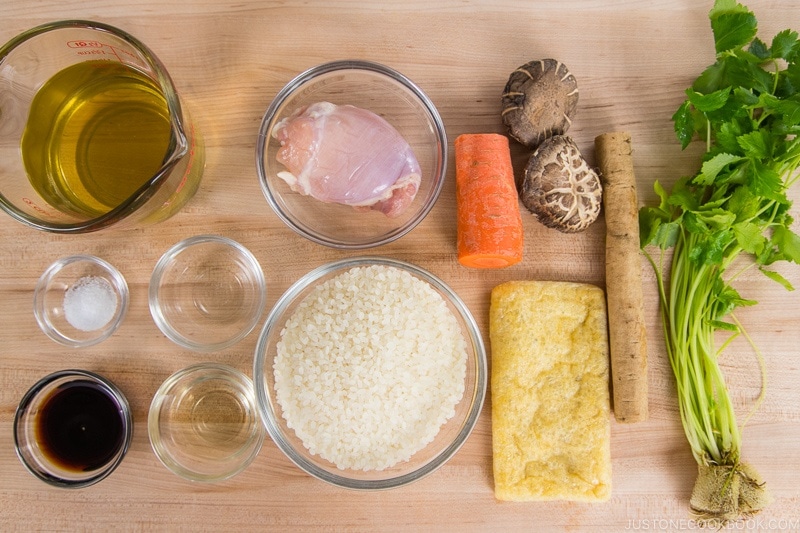
To Wash and Soak the Rice
- In a large bowl, measure and add 1½ cups uncooked Japanese short-grain white rice. Rinse the rice under cold water, gently rubbing the rice with your fingertips in a circular motion for 10–15 seconds. Add more water, then pour off the starchy water. Rinse and repeat until the water becomes clear. Then, add water to cover the rice and soak for 20–30 minutes. Meanwhile, start preparing the ingredients.
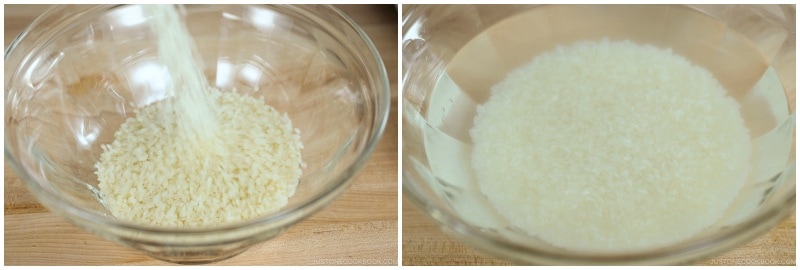
- Here‘s how the rice looks before and after soaking for 20 minutes. Drain the water completely. Set aside for 10 minutes. If you don’t have time to wait, then shake off the excess water the best you can.
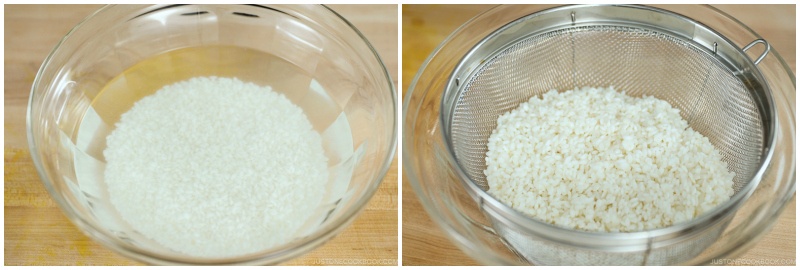
To Prepare the Ingredients
- In a small bowl, add 2 dried shiitake mushrooms and ¼ cup water. Put a heavy object on top so the mushrooms stay submerged in the water. Let them soak until they‘re tender. In the meantime, prep the other ingredients.
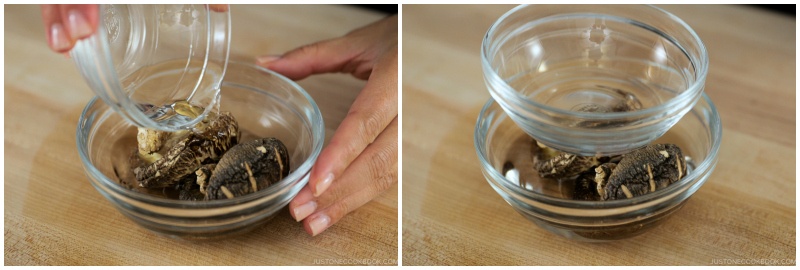
- Cut 1 chicken thigh into slanted, smaller bite-sized pieces. I use the sogigiri Japanese cutting technique to create more surface area so the meat will cook faster. Sprinkle the pieces with ½ Tbsp sake to remove any unwanted smell from the chicken.
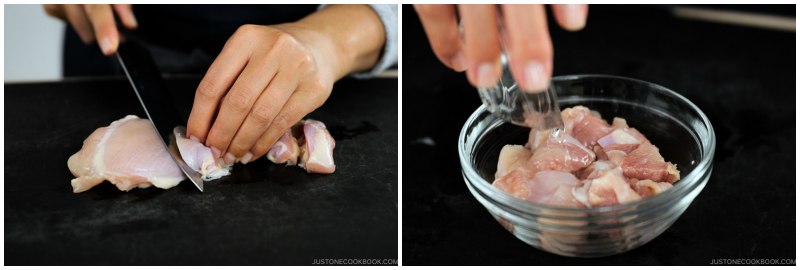
- With the back of a knife, scrape off the skin of 1.8 oz gobo (burdock root). Do not peel the skin with a vegetable peeler, which will remove the earthy and delicious flavor just below the skin. Cut the gobo in half lengthwise.

- Thinly slice each half diagonally. Soak the gobo in water to prevent it from turning brown and remove any astringent taste.
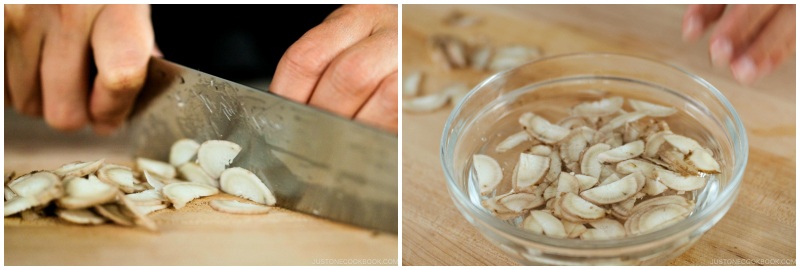
- Cut 1.8 oz carrot in half lengthwise and thinly slice it diagonally.
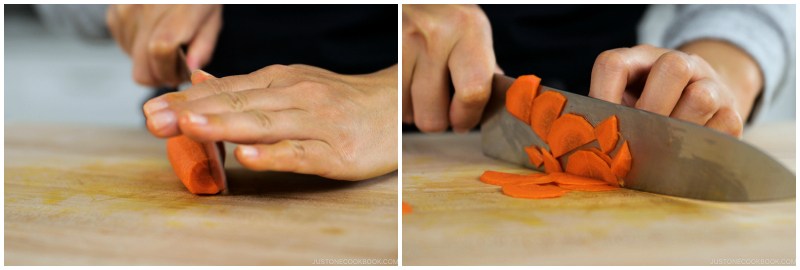
- Pour hot water over 1 piece aburaage (deep-fried tofu pouch) to get rid of the excess oil. Some people skip this step as the factory oil is cleaner these days. I do it anyway. Cut the aburaage in half lengthwise.
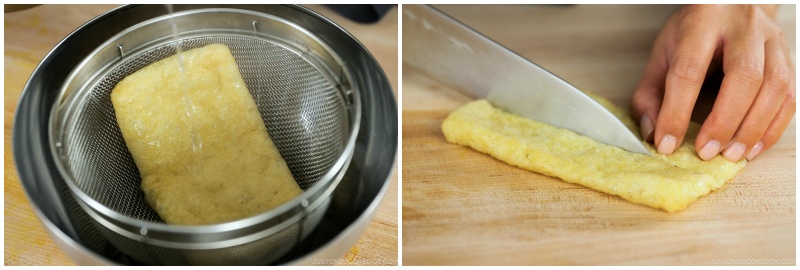
- Cut the tofu pouch into thin slices and squeeze out the water.
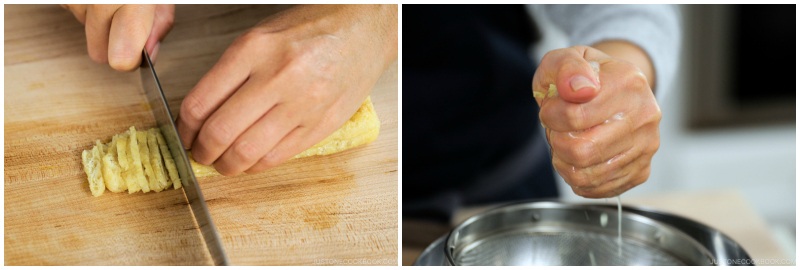
- You will need about ⅓ cup each of sliced carrot, sliced gobo, and sliced aburaage.

- By now, the shiitake mushrooms should be hydrated and tender. Squeeze out the excess liquid into the bowl and reserve this shiitake dashi to use later. Next, remove the stem from each shiitake mushroom.
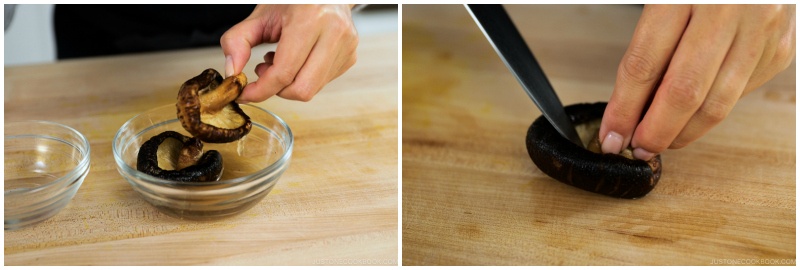
- Thinly slice the mushroom caps. If it’s a big mushroom, cut the thin slices in half crosswise.
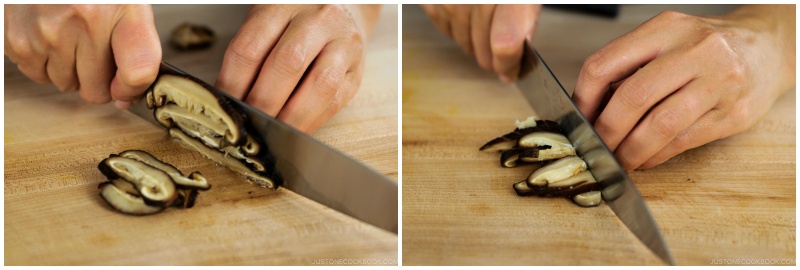
- In a 2-cup measuring cup, add 2 Tbsp shiitake dashi (the reserved liquid from hydrating the shiitake mushrooms). If you are worried about the small particles left in the liquid, you can strain the liquid using a tea strainer. To the same measuring cup, add 1½ Tbsp soy sauce, 1 Tbsp mirin, and ½ tsp Diamond Crystal kosher salt.

- Lastly, add enough of the 1½ cups dashi (Japanese soup stock) to the measuring cup so that the seasoning liquid measures 360 ml total.
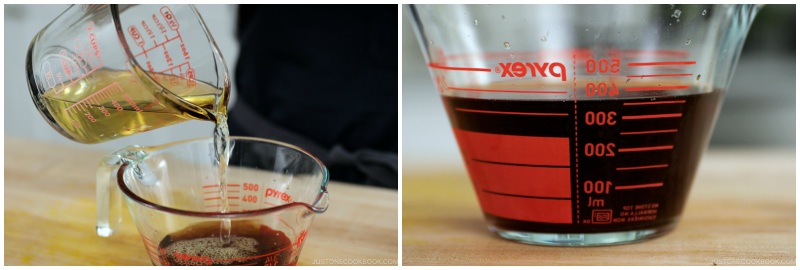
- To a large bowl, add the chicken, shiitake mushrooms, carrot, gobo, and aburaage. Then, add the 360 ml seasoning liquid from the previous step. Mix well.
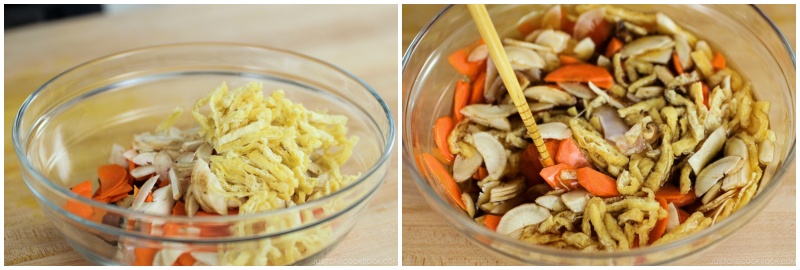
To Cook the Rice
- Transfer the well-drained rice to the rice pot. Make sure the rice is evenly distributed and flat.
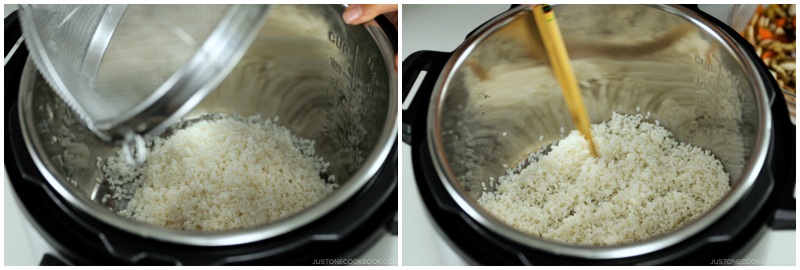
- Add the ingredients and seasoning liquid on top of the rice. DO NOT MIX the rice and the ingredients. Try to evenly distribute the ingredients on top and flatten them without mixing with the rice.
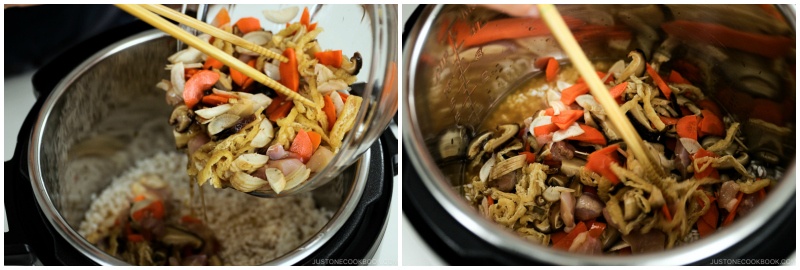
- Close the lid and click Manual. Set to High pressure for 2 minutes.
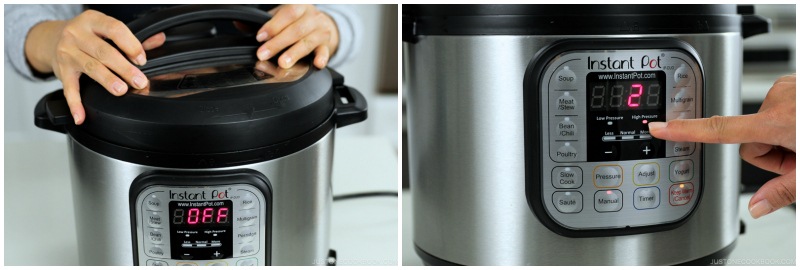
- Make sure the steam release handle points at Sealing and not Venting. The float valve goes up when pressurized (it takes roughly 10 minutes to pressurize).
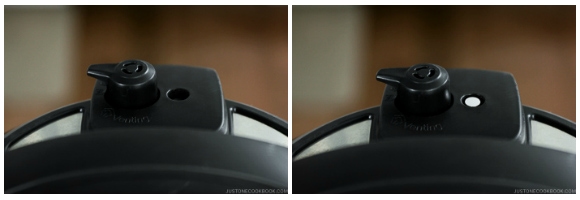
- When it’s finished cooking, the Instant Pot will beep and switch automatically to the Keep Warm mode. Let the pressure release naturally for 10 minutes; I recommend setting a timer. DO NOT EXCEED 10 MINUTES of natural release. After 10 minutes, proceed with a quick release by turning the steam release handle to the Venting position until the float valve drops down. Hold a kitchen towel over the steam release valve to protect your hand and face during quick release. Only a little bit of steam will be left after 10 minutes of natural release.

- Open the lid and immediately fluff the rice with a rice scooper to avoid burning the rice on the bottom. Instead of “mixing” the rice, try to “cut” it at a 45-degree angle using a slicing motion as you turn over each scoop of rice to fluff.
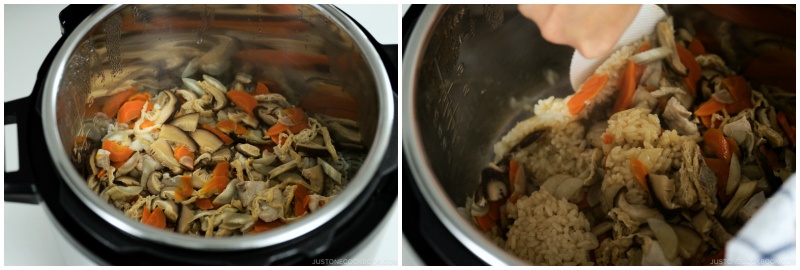
To Serve
- Cut 3 sprigs mitsuba (Japanese parsley) into small pieces. If you don’t have mitsuba, you can use green onion.

- Serve the Takikomi Gohan in individual bowls and garnish with the chopped mitsuba.
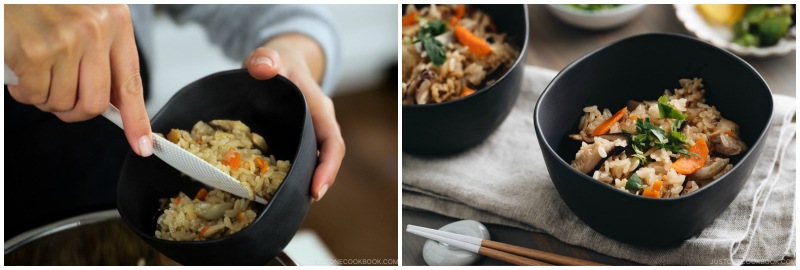
To Store
- The best way to store Japanese rice is to freeze it, even if you plan to use it the following day. To learn how, please read my post on how to store cooked rice.

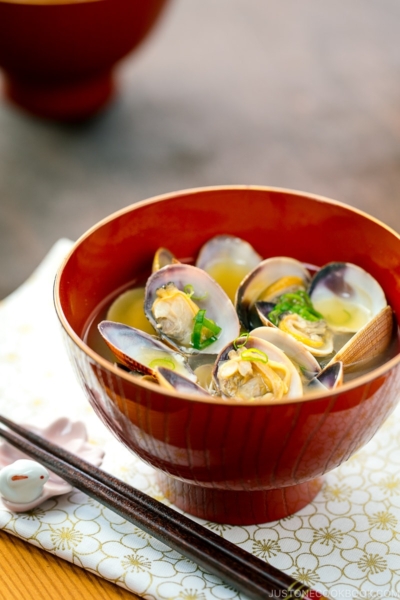
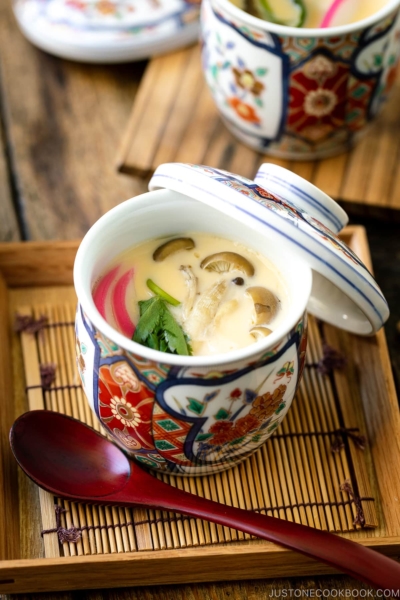
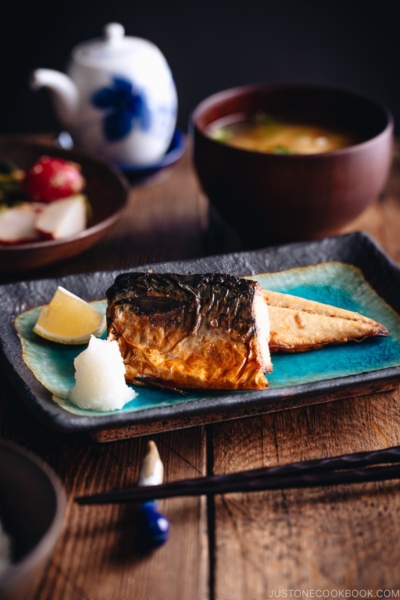
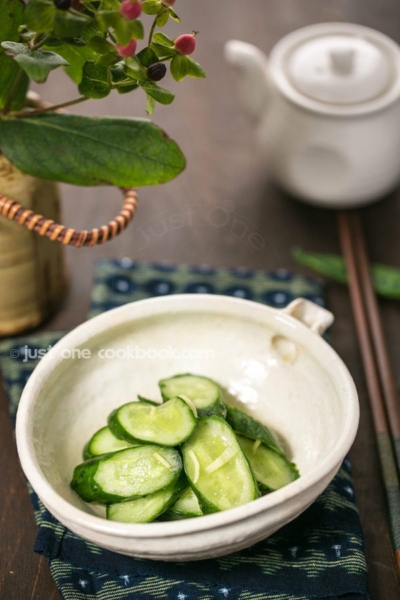




Excited to try this! Ingredient question: on your regular takikomi gohan recipe you show some types of fish as possible ingredients but not here. Is there some reason you wouldn’t use fish in the instant pot version?
Also, commonly stocked fishes in our household are salmon and cod, would you recommend either of these or not for takikomi gohan in general?
Hello, Kevin. Thank you for reading Nami’s post and trying her recipe!
You may also add the items indicated in the other version to this recipe. Salmon and cod would also work well.
We hope you enjoy exploring the many tastes. Happy Cooking!
We like parsnips when we can’t find burdock.
Hi Susan! Thank you for sharing your idea! This sounds great! 🙂
Hi there! i have made this before and it was so perfect but this time I got a burn notice! I don’t know what I did wrong.
Am thinking that I added more chicken but I don’t think so…am also thinking maybe there was not enough liquid with the rice?
Help!
Well to save it…I transferred it all to another bowl cos I have extra then I placed the rice mixture into a smaller bowl and decided to steam it. So its cooked now but I need to understand what I did wrong so I don’t repeat the same mistake.
This is Liane from the Philippines. Am such a fan of your blog!
Hello Liane! We appreciate your support for Nami’s blog and for trying out her recipes.😊
We would like to provide you with a list of things to keep in mind:
1. Ensure that the steam release handle is pointing towards “sealing” and not “venting”.
2. Clean the cooker base’s heating element and the pot’s bottom.
3. Verify that the silicone sealing ring is well-fitted and that it is clean and intact.
4. If you modify the recipe to serve fewer people, make sure to have at least 1 cup of liquid when making the Takikomi Gohan.
We hope this advice is helpful on your next try!
Didn’t work for me. The rice got stuck to the bottom and the InstantPot didn’t come to pressure. How do I fix this?
Hi Jess, Thank you for trying Nami’s recipe.
We recommend inspecting your pressure cooker’s sealing rings for damage and ensuring that the steam release handle is set to “sealing” rather than “venting.”
We hope this was helpful!
I made this recipe tonight. I didn’t have any gobo so added extra mushroom, carrots and tofu. It turned out really good. Delicious. Will definitely make again.
Hi Diane! Thank you very much for trying Nami’s recipe and sharing your experience with us.
We are so glad to hear that you enjoyed Takikomi Gohan.
Happy Cooking! 😊
Can we use Tempeh instead of chicken for a vegetarian version?
Hi Granthana, Thank you very much for reading Nami’s post!
We have never used Tempeh for this recipe and are not sure how the outcome will be.
Please let us know how it goes if you try it!
Made a double batch using carrot, daikon, Japanese sweet potato, and various mushrooms.
Even with the 2 minute cooking time, all items were cooked thoroughly.
The rice came out very sticky. More than i was expecting. I washed it thoroughly and let it dry as instructed. Is it supposed to be a sticky dish ? It was delicious, don’t get me wrong.
I enjoyed it with some furikake. Will definitely make again. Thanks as always Nami.
Hi Brett! Thank you very much for trying Nami’s recipe and sharing your cooking experience with us!
We are glad to hear you enjoyed the Takikomi Gohan!
This dish usually is not too sticky, but it will be if you add different vegetables like sweet potatoes. We recommend trying this dish without starchy vegetables next time.😉Thank you for your feedback. We hope this helps!
Hi,
I tried this dish for 8 servings and it came out great. Only thing is I think I used the wrong kind of dashi (will correct next time) causing it to be too salty.
Do I need to adjust ingredients or process if I use salmon instead of chicken?
Thank you.
Hi Saket! Thank you very much for trying Nami’s recipe and for your kind feedback!
To make this with salmon, you can follow the recipe as written and adjust the salt level as you like.
We hope this helps!
Hi Namiko,
In your video, the instant pot was set to high pressure, 2mins for 2 cups of rice. If i increase the use 3 cup of rice instead of 2 cups which means the dashi amount increases from 360ml to 540ml (dashi qty recommended by recipe scale based on pax), will the cooking time for the instant pot change? Kindly advise.
Thank you
Hi Kenny, Thank you very much for trying Namiko’s recipe!
If you are cooking 3 cups of rice (rice measuring cups), Nami recommends extending the cooking time to 3 minutes and natural release for 10 minutes. If it turned out harder than you prefer, try extending the natural release time to 12~14 minutes.
We hope this helps!🙂
This looks good! Two questions… 1. I do not eat meat, so if I just omit the chicken but leave everything else the same, would I still use the same amount of water? 2. I do not have a rice measuring cup. 1 rice measuring cup = how much in regular measuring cups? Thank you!
Hi Cat,
Please use the same amount of water.
And if you like more vegetables or mushrooms, you may add more to this recipe or just use the same amount.
You can also add Konnyaku. (Prepare same as Step 5 (boil and cut) in Hijiki salad recipe and add to the ingredient: https://www.justonecookbook.com/hijiki-salad/) It’s up to your preference.😉
As for the measuring, 1 rice cooker cup (1 gō / 1合) is 180 ml (150 g rice) instead of 200 ml or 240 ml.
We hope this is helpful!
So much faster than using a rice cooker, and in my opinion, the rice cooked better too, not mushy, not al dente, just perfect! I think this will be my go to method for takikomi gohan. I used dashi powder, I know you’re not a fan of it, Nami. It was a tad too salty with 1/2 tsp salt, next time I’ll add no salt if using dashi powder. Thanks for another great recipe!
Hi Olivia! I’m so happy to hear you liked this recipe and thank you so much for your feedback and letting us know about the dashi powder/salt! It’ll be very helpful for other readers! Thanks for trying this recipe. xoxo
This was so good! One of our favourite restaurants in San Diego has a kamameshi rice with butter, corn and scallop, which I was trying to recreate and found your post. I was a little hesitant to just do 2 minutes on the instant pot but it came out perfect! We almost could not stop eating it. Thank you for the recipe!
Hi Fran! I LOVE Kamameshi… how lucky you get to eat it in San Diego! Do they serve in the kama too? Thank you so much for trying this recipe. I’m so glad you enjoyed it! 🙂
Koinichiwa Nami san,
Thank u so much for your yummy receipes. I have been trying out lots of your dishes… all excellent👍👍👍
Question pls..
Do I have to soak Taiwanese short grain rice for 20 minutes too❓
To be honest, I never soak my rice (even Japanese rice) before cooking & it tastes just as good.
Tnx again.. be well
Tina
Hi Tina! Thank you for trying out my recipes. I’ve never tried Taiwanese short-grain rice, but if the roundness (thickness) is the same as Japanese rice, I’d say I would recommend soaking. 🙂
Thank you for the recipe! If I use the prepared mixed vegetables in the packet with liquid (maitake iri kinoko shigure), 260g. Do I use the liquid for dashi or throw it away? Thanks!
Hi Tiare! Are you using the Takikomi Gohan Mix? Then you put all in including the sauce. Then add the water until rice cooker measurement (I think…or follow the package instructions). 🙂
Hi Nami. I tried making this in the instant pot and got the burn message twice. I used different vegetables and hot water for the dashi broth. I am not sure if that’s what caused the burning. I have never received a burn message prior to trying this recipe. Not sure what went wrong 🙁
Hi Stella! That’s really rare – as I make takikomi gohan in the IP a lot but never happened. 1) what kind of vegetables did you add? Anything starchy, sticky, and how about the size? 2) did you add hot water to combine with the uncooked rice? If you are skipping dashi, it should be at least water, not hot water. 3) did you mix the rice and ingredients? You can’t do that, as ingredients may stick to the bottom. I’m happy to help investigate what went wrong, but without being in the kitchen with you it’s hard to figure out the problem… especially when different ingredients are used (it might be beyond my experience)… Let me know how I can help. Burnt message is supposed to show up when things are stuck on the bottom of the pot. Takikomi Gohan has enough water to cook the rice and nothing should be burnt on the bottom. Hope this helps a bit…